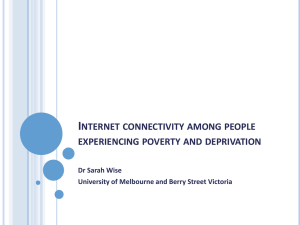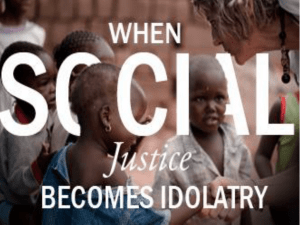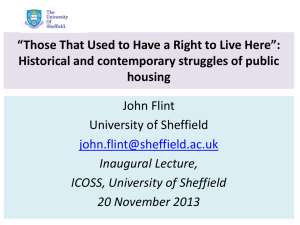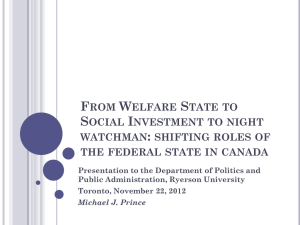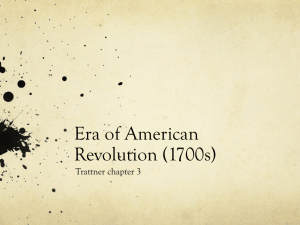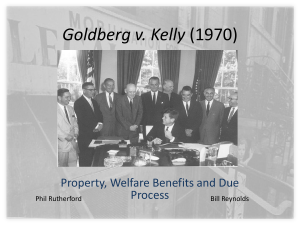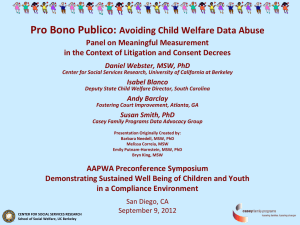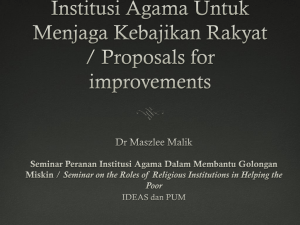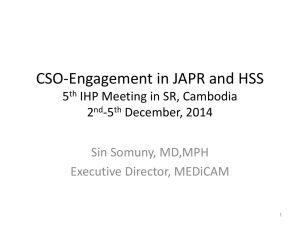Welfare Pluralism
advertisement
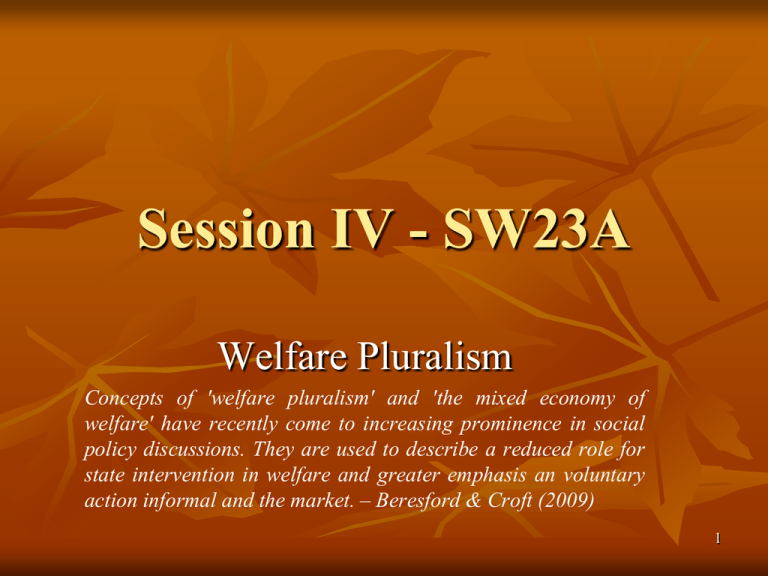
Session IV - SW23A Welfare Pluralism Concepts of 'welfare pluralism' and 'the mixed economy of welfare' have recently come to increasing prominence in social policy discussions. They are used to describe a reduced role for state intervention in welfare and greater emphasis an voluntary action informal and the market. – Beresford & Croft (2009) 1 Objectives Define welfare pluralism Delineate the role of the actors in the administration of welfare. Evaluate the legitimacy of welfare pluralism Conclude the best blend for the nations of the Region. Predict the role of human service professionals in administering welfare in the Caribbean. 2 The Context In some countries, nongovernmental organisations (NGOs) are major contributors to development processes. This is not uniform, however. In a number of countries, NGOs are weak or play more of an oppositional rather than operational role and governments are highly suspicious of them. 3 The Context The principal avenues by which governments can influence the operational environment for NGOs are: Nature and quality of governance (pluralism, accountability, etc.). The legal framework (registration, reporting requirements, etc.). Taxation policies (on imported goods, local philanthropy, etc.). Collaboration with NGOs (when? sector? nature of 4 partnership?). The Context The principal avenues by which governments can influence the operational environment for NGOs are: Public consultation and information (policy impact of NGOs). Coordination (role for governments in coordinating NGO activities). Official support (government funding, official contracts). 5 The Context NGOs have become important actors in development assistance for at least three reasons: First, because of their scale. In 1989, they contributed US$6.4 billion to developing countries (including $2.2 billion of official funds), representing some 12 percent of total development assistance. Second, because of their style of work. Many NGOs have demonstrated an ability to reach poor people, work in inaccessible areas, innovate, or in other ways achieve things which are difficult for 6 official agencies (Tendler 1982). The Context Third, many of them represent poorer people. Many NGOs have close links with poor communities. Some are membership organizations of poor or vulnerable people. Others are skilled at participatory approaches. 7 The Context The NGO attributes cited above have become increasingly important in recent years as: Official aid agencies and many governments seek to give greater attention to assisting women, the food insecure, indigenous peoples, AIDS sufferers/orphans and other vulnerable groups, which NGOs are better able to reach. Long experience of work with communities living in environmentally sensitive areas (including forests, desert margins, urban slums, etc.) provides NGOs with certain comparative 8 advantages in dealing with environmental issues. The Context There is a more clearly recognized need for pluralism and prominent citizens' voices in national development planning. NGOs can contribute to this in many ways including, at the local level, by the promotion of grassroots mobilization for social change (Clark 1991) or participatory development. 9 The Context There is increasing realization of the need to "roll back the State" in many countries where it has become over-extended. This gives greater prominence to the private and voluntary sectors. The rapid growth in numbers of NGOs many highly-specialized or localized which gives donors a wide choice of partners and considerable influence over those partners in many countries. This proliferation is highly country-specific. 10 Who Provides Social Services? Welfare services were historically provided by families, communities, religious orders, and private charities. Provision of social services by the state occurred in the 1st world with the advent of the “welfare state”, (Spicker, 2008). Very few developing countries are welfare states. 11 Welfare Pluralism – “mixed economy of welfare” Provision of social/welfare services by a range of social actors. Welfare pluralism involves six main actors State Non-partisan government Private sector Voluntary sector - NGOs and charities, Social/ Community/Special Interest/Religious groups Informal sector - family, friends, neighbours International Development Partners (IDPs) 12 Who Provides Social Services? The view of the State being central to organisation and delivery of welfare is “half truth at best” and Titmuss referred to the “social division of welfare” (Spicker, 2008; 135). 13 Welfare Pluralism Defined The coordination of service delivery through a plurality of service providers. The concepts of welfare pluralism (WP) and mixed economy of welfare (MEW), were formulated in the late 1970s and early 1980s in an attempt to emphasise the plurality of sources and forms of intervention in welfare. 14 Pertinent Questions regarding the Delivery of Social/Welfare Programmes Should the State provide universal coverage for all or should it be a residual provider for persons excluded from access to private provision? What scope & what extent? Should the State enter partnerships with the Private Sector and NGOs? On what terms? 15 Rationale for Welfare Pluralism Most countries already used this model In 1st world increasing costs (OPEC oil shocks of 1973 and 1979) strained fiscal resources The rise of economic neo-liberalism and the Washington Consensus in the 1980s (influenced primarily by Margaret Thatcher- UK and Ronald Reagan- US, called Thatcherism/ Reaganomics). 16 Neo-liberal Approach to Social Policy Neo-liberal advocates urged States to assume a ‘back seat’ position’. The market was seen as the best allocator of resources. This resulted in a move from the “welfare state” to the “welfare mix” (Dean, 2008) 17 After 1970s oil shocks, recession in North many countries experienced a period of economic stagflation (high inflation coupled with low growth). This reduced their ability to fund universal provision of social services. Third World countries were forced to cut social spending under structural adjustment programmes 18 The Case Behind reduced State Involvement High Cost for universal provisioning Inefficienct/ slow service provided government agencies Uneven coverage Poor quality service by 19 What must be the State’s Role under Welfare Pluralism? 1. Establishment of policy Only the State has the mechanism for taking decisions on social policy and welfare provisioning for the nation. 2. Providing the institutional and legal framework for the delivery of social services 20 State’s Role 3. Planning, designing and integrating health and education services State is able to capitalize on economies of scale in purchasing to obtain lower costs. Cost sharing sometimes used. 4.Establishment, maintenance of standards enforcement and minimum universal 21 What must be the State’s Role? 5. Regulation and monitoring of social services provided by State and allied non-state actors 6. Assisting disadvantaged groups through the provision of safety nets, subsidies etc. 22 What must be the State’s Role? 7. 8. To protect children & other vulnerable groups like elderly, mentally ill, and disabled. To step in to plug gaps when necessary services cannot be provided by the private market or will be closed because they are unprofitable. 23 Welfare Pluralism Private, Voluntary and informal sectors play an important role Citizens through voluntary groups, NGOs are participating more in discussions which shape social policy Role of IDPs becoming more important 24 Welfare Pluralism Inevitable Neo-liberal ideological shift Most states do not have the resources to provide for all welfare needs “It was only when it began to become apparent that government was neither willing nor able to ‘deliver the goods’ that unrest began to reappear, and private, voluntary initiatives in this sphere re-emerged” – Dr. Peta-Ann Baker writing about the post-Independence period in Jamaica (1993; 346) 25 Welfare Pluralism Ferreira (2008) believes that welfare mixes should be considered in their particular territorial contexts, policy fields and historical moments. Second, there is a plurality of sources of welfare such that the typical components of MEW can be complemented with those of the social division of welfare (SDW). While MEW concerns the articulation between welfare mechanisms such as state, market, voluntary and informal governance, SDW considers diverse means of welfare delivery such as statutory, 26 occupational and fiscal. The Social Division of Welfare Titmuss identified several different kinds of redistributive process, arguing that it was not possible to understand the redistributive impact of social policy without taking them fully into account. He referred to a 'social division of welfare', including three main types of welfare: 1. social welfare (the social services); 2. fiscal welfare (welfare distributed through the tax system); and 3. occupational welfare (welfare distributed by industry as part of employment). 27 The Social Division of Welfare The classification is fairly crude. The category of fiscal welfare bundles together subsidies, incentives and transfer payments, including income maintenance. Occupational welfare includes perks, salary-related benefits, measures intended to improve the efficiency of the workforce and some philanthropic measures. The classification excludes legal welfare (redistribution through the courts), the voluntary sector and the informal sector. 28 The Social Division of Welfare The importance of the idea was: to draw attention to different patterns of redistribution to explain that different kinds of redistribution (for example by tax or by benefits) can have similar effects, and to broaden the scope of social policy as a subject. 29 Welfare Pluralism Third, Ferreira (2008) showed that the provision, financing and regulation are three ways through which these sources intervene in welfare. Provision and production relate to the themes of production/ownership and to the question of who pays for welfare, regulation relates to legal political authority and can be measured in terms of the degree of control. 30 Welfare Pluralism The key effort to re-define the voluntary sector role as supplementary and complementary to the statutory sector was Beveridge's "Voluntary Action" of 1948. He set out the way forward for the voluntary sector as being advice, leisure, pioneering and experimentation, and this model remained the dominant ideology for the 1950s and the 1960s, leaving the voluntary sector on the periphery of the welfare state in the UK. 31 Welfare Pluralism Voluntary and nonprofit organisations in the world over are taking on increasing responsiblity for the delivery of social services to local communities. Many voluntary sector organisations have moved from being providers of supplementary and complementary services, to being providers of core statutory services under a formal contract. 32 Welfare Pluralism Inevitable Neo-liberal ideological shift Most states do not have the resources to provide for all welfare needs “It was only when it began to become apparent that government was neither willing nor able to ‘deliver the goods’ that unrest began to reappear, and private, voluntary initiatives in this sphere re-emerged” – Dr. Peta-Ann Baker writing about the post-Independence period in Jamaica (1993; 346) 33 Role of Voluntary Sector Diversifying social service provision and supplementing state services NGOs are seen as more effective in delivering aid, and ensuring that more $ reach the poor In 1981 US Congress mandated the USAID to allocate between 12 – 16% of its development funds to NGOs who are seen as more efficient utilizers of funds, than states 34 Role of Voluntary Sector Increasing citizen participation/ altruism Public advocacy on behalf of vulnerable NGOs see themselves “as partners of government, or they see themselves in compensatory and corrective roles: making up for the failings of the existing system, or serving as a ‘voice of the voiceless’ in pointing out these failings” (Baker, 347) 35 Role of Voluntary Sector Increasing accountability from the State & other welfare providers Assisting with poverty alleviation Assistance to excluded groups e.g. orphans, homeless, street children Provision of education and health care Role of Voluntary Sector Helping groups that might reject State services or might be stigmatized by State services (prostitutes, HIV/AIDS patients, drug addicts, prison ministry of churches) Risk of NGO sector being co-opted/used by foreign IDPs or local governments to further their own ends 37 Role of IDPs Very active in shaping the global social policy agenda Key agencies include United Nations Development Program - UNDP UNICEF UNFPA USAID PAHO/WHO 38 IDP Programmes poverty reduction programmes improving the welfare of women and children improving healthcare, e.g. immunization coverage, sexual and reproductive health, infrastructure projects, e.g. sanitation, water supply systems 39 The Role of the Private Sector Provision of social services at a cost, e.g. private schools, private medical facilities Provision of specialized services Occupational welfare to workers 40 The Role of the Private Sector Partnering with the State and other NGOs in welfare provision E.g.- Adopt-a-School programmes; Provision of computer labs Provision of medical equipment to hospitals Financing cost of CXC subjects by NCB ** Firms benefit from tax write-offs, creates good corporate image. 41 Limitations of Private Provision Private market does not respond to social need, will not provide services to areas/groups which are unprofitable. Externalities - Education, healthcare, parks etc. have value to society outside of the value to an individual/company. State services have other functions e.g. socialization, disease prevention 42 The Role of the Informal Sector Reduces the burden on the State Plugs gaps in state social services Care of sick, elderly or persons discharged from mental institutions provided . Thinking Point: Students to note implications of having welfare pluralism. 43 Approaches to Welfare Pluralism Approaches to the coordination of service provision: the use of the market to coordinate service delivery, with a reliance upon the price mechanism and a system of negotiated/competitive contracts to ensure service delivery. 44 Approaches to Welfare Pluralism Here, services are coordinated by using negotiated, and sometimes competitive, tendering processes. Providers face the transaction costs of tendering for these contract (particularly in terms of information about the services that they might contract for, and about the activities of their potential competitors/collaborators). 45 Approaches to Welfare Pluralism Build networks as a way to minimise these informational transaction costs by gaining information both from the purchasers about the service specifications and from competitors and collaborators about the range of alternative ways in which the service provision might be approached. 46 Kingston Restoration Corporation The KRC was formed in response to the dramatic economic and social deterioration of the downtown area of Kingston in the mid 1970s and early 1980s. This deterioration was a consequence of the numerous fires and riots that plagued the city, as a result of which many businesses migrated from the area. 47 Kingston Restoration Corporation As a result the Inner Kingston Development Project was born. This was a ten year urban economic and physical development initiative, which began in July 1986. It was designed to revitalize Kingston, Jamaica’s downtown core and provide work space for economic growth and job generation. The two principal implementing agencies were the Kingston Restoration Company Limited and the Urban Development Corporation, the primary developmental parastatal organisation of the Government of Jamaica with USAID being 48 the funding agency. Kingston Restoration Corporation The goal of the project was to reverse the negative economic trends and disinvestment that had been occurring downtown since the mid 1970s and contributed to Jamaica’s need for increased private investment and employment opportunities. 49 Kingston Restoration Corporation The rationale in 1986 for focusing the Project on Inner Kingston was threefold: (1) it had the highest rate of unemployment in the area, (2) reversing its deterioration would help to rekindle investment expectations nationwide and (3) the area offered significant opportunities for cost savings in development because infrastructure systems were in place and vacant building shells could be rehabilitated and put to productive use economically. 50 51 KRC Micro Enterprise Financing Limited (MEFL) is a not-for-profit corporation limited by guarantee, dedicated to assisting in the development of micro enterprises in designated urban communities of Jamaica. MEFL was incorporated on May 7, 2002 and is located at 12 Duke Street, Kingston and three rural branches in the parishes of St. Elizabeth, Westmoreland and St. Catherine. 52 KRC The general purpose of MEFL will be to make microfinance services available to the low income, urban and rural, micro entrepreneurs with little or no collateral, while branching out to a similar of communities elsewhere in Jamaica in due course. Loans are made at existing micro finance market rates and following standard business practices. 53 KRC MEFL is sponsored by the Canadian International Development Agency (CIDA), The Bank of Nova Scotia Jamaica Ltd (BNSJ) and Kingston Restoration Company (KRC) BNS provide capitalization in the form of loans to the organization and CIDA provided funding to cover operational start-up cost. KRC is the community agent, assisting with promotion and the identification of suitable borrowers/group of borrowers. 54 Approaches to Welfare Pluralism Approaches to the coordination of service provision: the use of hierarchical arrangements to coordinate service delivery, either in the form of bureaucratic planning and coordination systems; or by the vertical integration of service providers into the purchasing agencies. In this case line management relationships will be used to coordinate service delivery. 55 Approaches to Welfare Pluralism The hierarchical methods used here serve to coordinate service provision, by a pyramidal structure of planning committees, which fed unmet needs from local communities to the central purchasing function of the authority. This structure is strong on accountability. However, the length of time involved in responding to some unmet need in local areas could be a transaction cost of this mechanism. 56 Approaches to Welfare Pluralism Build networks at the local level between the agency and service providers to short-cut the structure and respond more quickly to such needs. 57 The CHASE Fund The Culture, Health, Arts, Sports and Education Fund CHASE was incorporated on November 25, 2002 and began its operations in January 2003. It was registered under the Companies Act to receive, distribute, administer and manage the monetary contributions from the lottery companies in Jamaica in connection with: Sports Development Early Childhood Education Health 58 Arts and Culture The CHASE Fund The company became a reality based on the concept of ‘taxes foregone’ that would have normally gone to the consolidated fund. The approach had as its precedent the establishment of the Sports Development Foundation (SDF) to receive a percentage of the proceeds earned by the first licencee permitted to conduct a lottery, the Jamaica Lottery Company. 59 The CHASE Fund Prior to the establishment of CHASE, the Sports Development Foundation (SDF), reported to the National Council on Sports and the Minister of Sports. This relationship continues though funds for the SDF are now routed through CHASE. 60 The CHASE Fund A special Advisory Committee was established to exercise general management and control of the funds made available for Early Childhood Education by the lottery companies. The Committee has representatives from the Ministry of Education, Jamaica Lottery Company, Supreme Ventures and three independent members. 61 The CHASE Fund A Trust Fund known as the Health Support Fund within the Ministry of Health was established to receive and administer the contributions made to health. Requests for equipment, etc. were submitted to the Board of Trustees and evaluated by a sub-committee of the Board. The Board of Trustee made the final decision as to which projects were to be funded. 62 The CHASE Fund The rationale for the establishment of the CHASE Fund hinges on the assumption of greater efficiencies to be realized from a central administration. The funds of the CHASE Fund are to be allocated in the following proportions: Sports Development - 40% Early Childhood Education - 25% Health - 20% Arts and Culture - 15% 63 The CHASE Fund In relation to Sports Development, the Fund will disburse monetary contributions to the Sports Development Foundation (SDF) for the benefit of various sporting interventions. The CHASE Fund is Managed by an twelve (12) member Board supported by a Chief Executive Officer and staff. 64 The CHASE Fund The CHASE Fund will administer and manage the allocations to satisfy the following objectives: Improvement of libraries, archives and documentation facilities Implementation of programmes to expose and encourage the people of Jamaica, especially the young, to utilize facilities such as libraries, archives, and documentation. Establishment, funding and implementation of programmes for the development of talents and skills in the youth of Jamaica in the areas of 65the Arts and Culture The CHASE Fund Utilization of cultural activities in the conveying of development objectives Acquisition, restoration, maintenance or use of historic sites and monuments Establishment of opportunities for cultural display and exhibitions to facilitate the show-casing of Jamaican culture Provision of opportunities for more people to attend and participate in artistic activities To assist in the creation and preservation of documentary film footage on Jamaica’s history 66 The CHASE Fund The CHASE Fund will administer and manage the allocations to satisfy the following objectives: Implementation of programmes for the development of healthy lifestyles in Jamaica; and to assist and promote with grants or otherwise the development and improvement of health facilities in Jamaica. Building, upgrading, restoring and equipping health facilities, children’s homes, palliative and drug rehabilitation centres, AIDS hospices and shelters for the homeless. 67 The CHASE Fund Training of personnel to administer and operate health facilities, children’s homes, palliative and drug rehabilitation centres, AIDS hospices and shelters for the homeless. Upgrading of health care facilities and provision of additional services for the delivery of Health care to the mentally challenge. Collaboration with the private sector in the delivery of health care. 68 The CHASE Fund Assisting in the development of programmes to facilitate the design of plans and strategies for the prevention of drug abuse among children. Supporting programmes designed for community involvement so as to bring about a decrease in the incidence of drug abuse and its adverse effect on the community. Development and implementation of programmes for cancer prevention, detection, treatment and care. 69 The CHASE Fund Sports create opportunities through which talented Jamaicans are being nurtured for national and international competition. CHASE is deeply committed to providing financial support for the development of the nation’s athletes, and providing world-class athletic facilities, working through the Sports Development Foundation. 70 The CHASE Fund Funds go towards: Support for programmes that develop dynamic leadership qualities in youth; Focussing on sports development as part of the process of national building; Promotion and encouragement of the development of talent and skill in sports that will uplift the social and economic development of the Jamaican people. 71 The CHASE Fund The CHASE Fund will administer and manage the allocations to satisfy the following objectives: Health screening of children in early childhood institutions Building, upgrading and equipping of early childhood resource centres (including furniture and learning materials) Support for development/manufacture of early childhood materials to enhance the cognitive 72 development of children. The CHASE Fund Improvement of the nutritional status of pupils in Basic and Infant schools; or Infant schools and Infant departments within Primary and All Age schools. Support the early childhood training programmes both pre service and in-service. Provision of scholarships for specialists training in Early Childhood Education Support for local and regional Early Childhood conferences and public education activities. 73 The CHASE Fund Institutional strengthening of the National Early Childhood Programme Special provisions to extend resource centre facilities in communities which cannot access parish based centre facilities. Assist communities and charitable and non-profit organizations in providing out-of-school-hours child care. Expand the use of radio and televisions programmes to enrich and support the curriculum. Support research for the development of early 74 Approaches to Welfare Pluralism Approaches to the coordination of service provision: the use of clans to coordinate service delivery. These cut across any formal market or hierarchical arrangements by utilising the informal network linkages between organisations. In this case coordination will be through these networks, with a consequent reliance upon personal relationships. 75 Approaches to Welfare Pluralism The provision social services is coordinated through the local 'clans' of (Ouchi, 1980) service purchasers and providers. Historically there will have to be a close knit relationship between these organisations and this pre-existing pattern of relationships is used to coordinate a service provision. 76 Approaches to Welfare Pluralism Value driven and speedy service delivery is based on trust. This coordinating mechanism thus possesses a strong institutional bias in its selection of potential service providers. May not respond to all community needs because providers who are “out” are not included among service providers. 77 Jamaicans for Justice Jamaicans for Justice (JFJ) is a non-profit, non-partisan, non-violent volunteer citizens’ rights action organisation founded in 1999. MISSION Through the works of our action group we will bring about fundamental change in Jamaica ’s judicial, economic, social and political systems in order to improve the present and future lives of all Jamaicans. 78 Jamaicans for Justice VISION A Jamaica where the rights of all are ensured; where there is equal opportunity for citizens to realize their full potential and enjoy a sense of wellbeing; and where our culture is enhanced and respect shared. VALUES Truth, Transparency, Integrity, Empathy, Humility, Respect. 79 Jamaicans for Justice BELIEFS Justice is the bedrock of any civilized and progressive society and all Jamaicans must have equal access to fair and impartial treatment. Jamaicans are decent, law-abiding citizens; that each person is innocent until proven guilty in a Court of Law, and that each citizen deserves respect, freedom and the right to enjoy a peaceful existence. 80 Jamaicans for Justice BELIEFS We believe in the protection of the Constitutional rights of every human being. Not only an organizational credo, our belief in protecting the basic rights of all citizens of Jamaica is reinforced by the recognition and acceptance of The Universal Declaration of Human Rights (UDHR). 81 NGOs in the Caribbean – Belize Alliance Against AIDS: The Alliance Against AIDS was founded in 1997 and offers helpline and counseling services to those affected with HIV and AIDS. They also do pre-test and posttest counseling, as well as educational seminars and events. 82 NGOs in the Caribbean – Belize Belize Red Cross Society: The Belize Red Cross Society (BRCS) has a clear mission that reflects the Fundamental Principles. The society has a good relationship with the government, notably the ministries of health, education and human development. The most important areas of cooperation with the government are health including HIV/AIDS and disaster preparedness. The society maintains good relations with other organizations at the local level and has a very good 83 image in the community and the media. NGOs in the Caribbean – Belize Belize Family Life Association (BFLA): The Belize Family Life Association (BFLA) was established in 1985. BFLA is dedicated primarily to family planning and reproductive health. From it's six centers throughout Belize, BFLA provides a range of reproductive health services including pregnancy tests, STD diagnosis and treatment, pap smear diagnosis and treatment of the early stages of dysplasia, and counseling in sexual and reproductive health. 84 NGOs in the Caribbean – Belize SPEAR - Society for the Promotion of Education and Research: The Society for the Promotion of Education and Research (SPEAR) is one of Belize's leading civil society organizations. It is a non-government, nonpartisan and not-for-profit membership organisation. SPEAR was formed in 1969 with the aim to contribute to the making of modern Belize through increased national and political 85 consciousness and people's participation. NGOs in the Caribbean - Barbados NGOs such as the Vagrants & Homeless Association, Barbados Youth Business Trust, Pinelands Creative Workshop, Mens Educational Support Association and Bush Hall Institute for Action & Research do critical work at the grassroots level and with youth. 86 NGOs in the Caribbean – Trinidad & Tobago Chaguaramas Dev. Solutions For Hunger The Hibiscus Foundation Families In Action YMCA Trinidad & Tobago Friends of Tobago AIDS The Cropper Foundation Mamatoto Citizens for better T&T Energy Skills Center Love In Action 87 NGOs in the Caribbean – T&T Hawks International Torres Foundation Persons with Disabilities The Heroes Foundation The Shelter Self Empowerment Police Complaints Authority Greater Chaguanas Chamber Empowerment Society T&T Chamber UWI Student Endeavours The Barcam 88 Approaches to Welfare Pluralism Note that there is no normative resolution of these differing patterns of coordination and of networks. Each is a specific response to its context, and in particular to the transaction costs that service provision imposes upon the agency. 89 Advantages/Strengths of Welfare Pluralism Reduces financial burden on state Diversity – range of services widened Coverage Altruism encouraged in the society 90 Weaknesses of Welfare Pluralism Fragmentation of service delivery Access Variation in standards and quality of services Cost of coordination/administration 91 Benefits of Welfare Pluralism Joint planning - offers status, recognition of expertise, and access into the hierarchy. Accountability – resource allocation; coverage of community Culture - changes possible in the culture of the voluntary sector. Shift from informal partnerships to more formal contracts. Relevance - represent the interests of persons who use or are likely to use the services. 92 Benefits of Welfare Pluralism Skills Transfers – budgeting, Grant Writing, etc. Costing – addition of costs which cover central administration/salaries etc.? Independence – does coming into the main stream compromise independence? 93 Benefits of Welfare Pluralism Partnerships flourish when both partners have something to offer and something to gain. Despite the enormous differential in finances, status and perceived power, partnerships between the public sector and voluntary organisations of any size arise because each has something the other needs. 94 Benefits of Welfare Pluralism The benefits to the voluntary sector are perceived to be security, clarity and income generation. The benefit to the public sector is clarity on the “real” needs of local communities. 95 Thinking Points What is the role of Social Work and other Human Services Organisation professionals in working in a system of welfare pluralism? What are the options to this arrangement? 96 Your Role Role of Social Work and other Human Services Organisation professionals: Mentors/Leaders Lobbyists/Advocates/Educators Developers and implementers of social policy. 97
